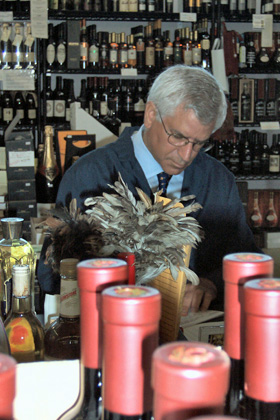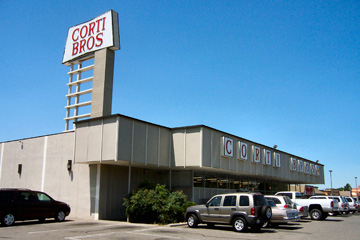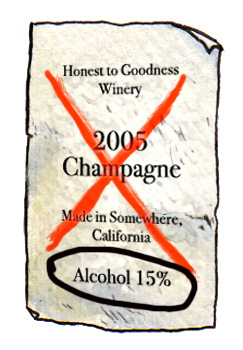

Will wineries listen to Darrell? "With the number of wines that are around, it’s not very difficult to find wines that will fit into a category. … But it’s become more difficult to find wines that are balanced, tasty and are not high in alcohol."
California (State Appellation)
Wine merchant Darrell Corti no longer sells wines over 14.5% alcohol.
"There will be no exceptions."
by
Alan Goldfarb
June 17, 2007
ALAN GOLDFARB (AG): Set the record straight for us: I understand you will not be tasting wines over 14.5 percent alcohol for possible inclusion in your store.
DARRELL CORTI (DC): At our store, after a tasting on the 29th of March, I put on top of the Zinfandel section, “This is the last tasting Corti Brothers will do for over 14.5 percent Zinfandels. These wines will no longer be sold at Corti Brothers. There will be no exceptions.”
I did it after we tasted Zinfandels that were 14.6, 15.1, 15.6, 15.2, 15.1, and 17 percent alcohol.
AG: What was your motivation?
DC: They (high alcohol wines) make you very tired. My idea of a really good bottle of wine is that two people finish the bottle and wish there was just a little bit more. Some of these wines with high levels of alcohol -- you can’t finish the bottle. You don’t want to finish the bottle.
My idea of a really good bottle of wine is that two people finish the bottle and wish there was just a little bit more. Some of these wines with high levels of alcohol -- you can’t finish the bottle. You don’t want to finish the bottle.
AG: Does this only apply to Zinfandel?
DC: It doesn’t mean that there are any circumstances where this won’t work. But it makes no sense to me to have a class of table wine, which is a legitimate description of wine created by the ATF (sic), that in the old days, anything that was over 14 percent alcohol was considered a dessert wine.
(But) everyone wants to make some things very attractive for certain wine writers. Zinfandel is the only one that does that consistently. (Although) I was shown a Syrah from Paso Robles that was 15.3 percent . I won’t taste it. Some say, “You sell Amarone, which is over 16.5.” Yes, but they’re made to be like that. So, it doesn’t need to apply just for Zinfandels. (But) I don’t like drinking them. I just got back from southern Italy. Some of the wines I had there were 11, 12 percent, and they were absolutely delicious.
I’m not out to tilt at windmills but (British wine writer) Jancis Robinson said she likes wines for their “refreshing quality.” Wines that are over 14 percent alcohol aren’t particularly refreshing.
Winemakers (who make their wines high in alcohol) say “we need lots of flavor.” To do what with?
AG: What has been the reaction from your customers?
DC: Customers bitch and complain that they won’t spend a lot of money for good (lower alcohol) German wines, but they spend it for white Burgundies. I don’t see the difference, except one is more expensive than the other.
At one time Bordeaux wines used to be 12.5 to 13 percent in a great vintage, and now they’re well over 13 or 14. It doesn’t make them better wines, just different. But I would like them to behave like they’re supposed to behave.
AG: So, will you take those wines off the shelves, too?
DC: No, we just won’t replace them. With the number of wines that are around, it’s not very difficult to find wines that will fit into a category. … But it’s become more difficult to find wines that are balanced, tasty and are not high in alcohol.
AG: So, what has been the reaction to your stance?
DC: There has been more reaction on the part of people who write about wine than on the part of people who buy wine
BIG WINES OFF LIMITS: At Corti Bros. Market in Sacramento, CA, no wines over 14.5% alcohol will be sold.and drink it. As far as anything that happens about wine, more or less, is of more interest to people who write about wine.
We’ve had faxes that say “Bravo!” Some people say, “Keep it up.” Some say this is foolish. But I can sell what I want to sell, can’t I? Only once, a customer came in asking for a big Zinfandel. I said, ‘We don’t have wines like that. Since I don’t like them, why would I sell them?’
And then there are people like (wine critic Robert) Parker, who really put their foot in it. He wrote (on his Web site’s message board) that he had bought an imperial of Corti Bros Zinfandel 1976 (from Amador County that was bottled for the store) that was more than 15 percent alcohol. (But) he couldn’t have: there was no Corti Brothers ’76. The only time we bottled an imperial was in 1974 and those were 13.9 according to the label.
We don’t pay much attention to what Parker or the Wine Spectator says. He’s the one who’s caused all of this problem. (Here) you have someone who actually creates the market, but in the old days it used to be the king of France who created the market for wines. When he gives a wine 100 points, or a 98, 95, or 93 … other wineries are going to imitate them. Wineries are noted for following the trend so they can sell wines.
AG: So, is what you’re doing going to start a trend toward lower-alcohol wines?
DC: I have no idea. (But) I can tell you that last night I went to a birthday party where there were a number of Cabernet Sauvignon from 1997 – very famous names. And there was a certain sameness to them. At one time you could actually distinguish between them. Now you can hardly distinguish between producers.
AG: What is going to happen then? Will styles begin to change?
DC: I would love to see a trend downward. … But it’s like crying in the wilderness.
DARRELL CORTI (DC): At our store, after a tasting on the 29th of March, I put on top of the Zinfandel section, “This is the last tasting Corti Brothers will do for over 14.5 percent Zinfandels. These wines will no longer be sold at Corti Brothers. There will be no exceptions.”
I did it after we tasted Zinfandels that were 14.6, 15.1, 15.6, 15.2, 15.1, and 17 percent alcohol.
AG: What was your motivation?
DC: They (high alcohol wines) make you very tired.
 My idea of a really good bottle of wine is that two people finish the bottle and wish there was just a little bit more. Some of these wines with high levels of alcohol -- you can’t finish the bottle. You don’t want to finish the bottle.
My idea of a really good bottle of wine is that two people finish the bottle and wish there was just a little bit more. Some of these wines with high levels of alcohol -- you can’t finish the bottle. You don’t want to finish the bottle.
AG: Does this only apply to Zinfandel?
DC: It doesn’t mean that there are any circumstances where this won’t work. But it makes no sense to me to have a class of table wine, which is a legitimate description of wine created by the ATF (sic), that in the old days, anything that was over 14 percent alcohol was considered a dessert wine.
(But) everyone wants to make some things very attractive for certain wine writers. Zinfandel is the only one that does that consistently. (Although) I was shown a Syrah from Paso Robles that was 15.3 percent . I won’t taste it. Some say, “You sell Amarone, which is over 16.5.” Yes, but they’re made to be like that. So, it doesn’t need to apply just for Zinfandels. (But) I don’t like drinking them. I just got back from southern Italy. Some of the wines I had there were 11, 12 percent, and they were absolutely delicious.
I’m not out to tilt at windmills but (British wine writer) Jancis Robinson said she likes wines for their “refreshing quality.” Wines that are over 14 percent alcohol aren’t particularly refreshing.
Winemakers (who make their wines high in alcohol) say “we need lots of flavor.” To do what with?
AG: What has been the reaction from your customers?
DC: Customers bitch and complain that they won’t spend a lot of money for good (lower alcohol) German wines, but they spend it for white Burgundies. I don’t see the difference, except one is more expensive than the other.
At one time Bordeaux wines used to be 12.5 to 13 percent in a great vintage, and now they’re well over 13 or 14. It doesn’t make them better wines, just different. But I would like them to behave like they’re supposed to behave.
AG: So, will you take those wines off the shelves, too?
DC: No, we just won’t replace them. With the number of wines that are around, it’s not very difficult to find wines that will fit into a category. … But it’s become more difficult to find wines that are balanced, tasty and are not high in alcohol.
AG: So, what has been the reaction to your stance?
DC: There has been more reaction on the part of people who write about wine than on the part of people who buy wine

BIG WINES OFF LIMITS: At Corti Bros. Market in Sacramento, CA, no wines over 14.5% alcohol will be sold.
We’ve had faxes that say “Bravo!” Some people say, “Keep it up.” Some say this is foolish. But I can sell what I want to sell, can’t I? Only once, a customer came in asking for a big Zinfandel. I said, ‘We don’t have wines like that. Since I don’t like them, why would I sell them?’
And then there are people like (wine critic Robert) Parker, who really put their foot in it. He wrote (on his Web site’s message board) that he had bought an imperial of Corti Bros Zinfandel 1976 (from Amador County that was bottled for the store) that was more than 15 percent alcohol. (But) he couldn’t have: there was no Corti Brothers ’76. The only time we bottled an imperial was in 1974 and those were 13.9 according to the label.
We don’t pay much attention to what Parker or the Wine Spectator says. He’s the one who’s caused all of this problem. (Here) you have someone who actually creates the market, but in the old days it used to be the king of France who created the market for wines. When he gives a wine 100 points, or a 98, 95, or 93 … other wineries are going to imitate them. Wineries are noted for following the trend so they can sell wines.
AG: So, is what you’re doing going to start a trend toward lower-alcohol wines?
DC: I have no idea. (But) I can tell you that last night I went to a birthday party where there were a number of Cabernet Sauvignon from 1997 – very famous names. And there was a certain sameness to them. At one time you could actually distinguish between them. Now you can hardly distinguish between producers.
AG: What is going to happen then? Will styles begin to change?
DC: I would love to see a trend downward. … But it’s like crying in the wilderness.










 READER FEEDBACK: To post your comments on this story,
READER FEEDBACK: To post your comments on this story,




